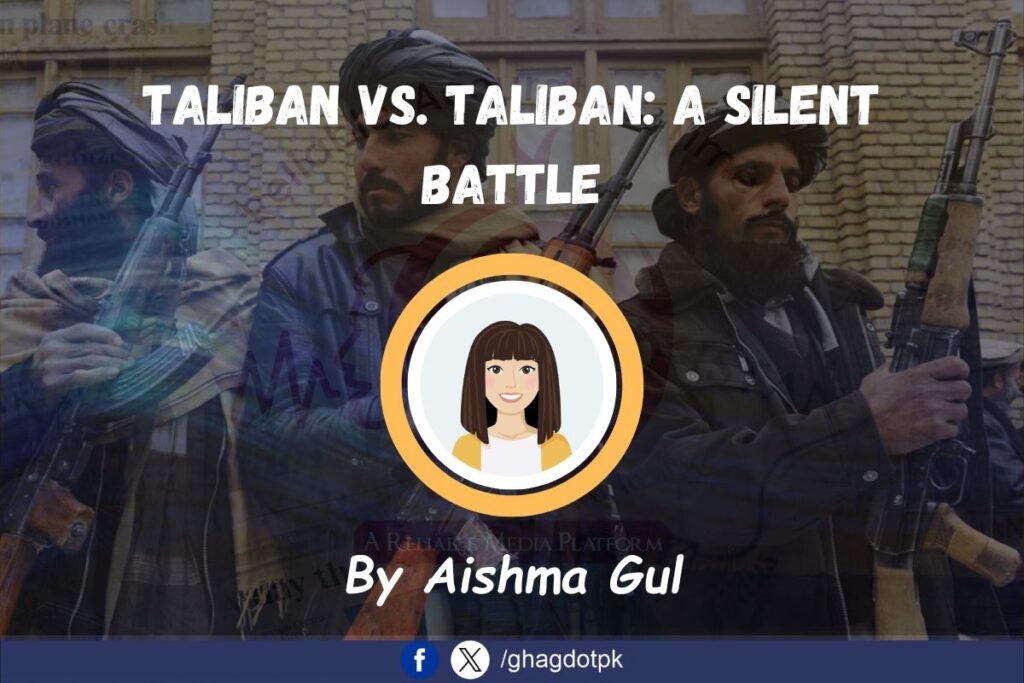By Aishma Gul
”A house divided against itself cannot stand.”— Abraham Lincoln’s words starkly reflects the growing internal discord of the Afghan Taliban. Once united in their campaign against foreign forces, the group now faces fractures that threaten their cohesion — and the stability of the region. How do these divisions shape not only Afghanistan’s future but also the security dynamics of neighboring Pakistan, particularly its Khyber Pakhtunkhwa (KPK) province?
Unity: An Elusive Dream
Since the Taliban took power again in 2021, they have appeared to be united. However, beneath the surface, there are growing differences in their ideologies and strategies. Reports mention that agreements on governance, women’s education and foreign policy remained unresolved, with key leadership positions unfilled amid factional infighting. The political deputy appointment delay—previously heeded by Abdul Kabir—is a concrete example of the power struggle between rival power blocs. Senior figures such as Sher Mohammad Abbas Stanikzai have publicly called out the leadership-among increasingly tension filled exchanges.
The Isolationists of Kandahar Vs The Pragmatists of Haqqani
At the heart of the rift are two prevailing camps:
– The Kandahar Clerics: Under the leadership of Supreme Leader Mullah Hibatullah Akhundzada, this faction is primarily concerned with Islamic governance and isolationism, refusing most foreign engagement.
– The Haqqani Network: Led by Interior Minister Sirajuddin Haqqani, it favors pragmatic diplomacy in order to gain international recognition and economic support.
The long absence of Sirajuddin Haqqani from important meetings since late 2023 highlights his gradual diminishing influence, while the Defense Minister Mullah Yaqoob — son of the Taliban founder Mullah Omar — advocates for a centralized military command. One anonymous Taliban official put the schism starkly: “Some want isolation; others know survival requires trade and recognition.”
Financial Strains and Resource Wars
The Taliban’ lack of access to $9.5 billion in frozen foreign reserves has fueled competition for revenue streams. New taxes are now collected by local commanders in Helmand and Nangarhar on illicit mining and narcotics, money that is being siphoned off from Kabul. The element of cross-border smuggling, including routes through KPK and Balochistan, increased at the rate of 27% in 2023 as some factions took advantage of Pakistan routes to manage central scrutiny.
Illegal mining of lithium and rare earth minerals in Afghanistan has already caused environmental degradation, including a 19 percent increase in deforestation along Afghan-Pakistani border regions that exacerbate flood risks to KPK’s Swat Valley.
A Shift in Haqqani Network Strategy
The Haqqani Network, historically based in North Waziristan, now reportedly relocated in Paktika Province close to Balochistan poses a threat to Pakistan’s security calculus. Yet this move eases immediate pressure on KPK, while intensifying challenges in Balochistan, with Taliban aligned actors now engaged in 15% of the informal economy there. Pakistan’s security forces are in a tricky situation. If they try to limit the Haqqani network’s influence, they might reduce some immediate threats, but they could also empower more extreme groups that oppose cooperation with neighboring countries.
Pakistan’s Multi-Track Challenge: The Spill-Over Effects
– Security Dynamics in KPK: After 2021, Militant incidents in districts such as Bajaur have risen by 34% with disconnected factions of the Taliban collaborating with groups such as TTP. This is also being countered by Pakistan’s military by way of counter-terrorism operations such as Azm-e-Istehkam — where over hundreds militants were neutralised.
– Balochistan’s Silent Crisis: Taliban infighting has shifted smuggling routes to Balochistan, threatening Quetta’s attempts to formalize trade. The military’s “development-first” strategy combines construction projects such as the Gwadar-Khuzdar Highway with intelligence-led crackdowns.
– Radicalization in the Digital Space: A 42% increase in Pashto language extremist material has been identified targeting KPK’s youth, leading to cooperation between Pakistan’s National Counter-Terrorism Authority (NACTA) and technology corporations to close 300+ extremist channels in 2024.
– Refugee Strain: New refugee waves in Pakistan would strain KPK’s resources; Pakistan is home to 1.3 million registered Afghans. Biometric registration efforts are designed to differentiate conflict-induced refugees from economic migrants.
The China Factor: CPEC Under Threat
Balochistan’s importance to China’s CPEC projects makes it a target for rival Taliban factions seeking leverage. A January 2024 attack on a convoy in Zhob led Beijing to request improved security. Pakistan’s deployment of a Special Security Division with AI surveillance underscores the commitment to safeguarding CPEC without direct militarization.
The Taliban’s internal fractures go beyond political differences, imperiling Afghanistan’s governance, regional security and environmental stability. The fall out for Pakistan calls for imaginative responses that blend military precision with socio-economic as well as environmental foresight. While Pakistan’s security forces remain a bulwark against chaos, the path forward hinges on anticipatory action—transforming Afghanistan’s crisis into an opportunity for regional recalibration. As Lincoln had warned, division breeds vulnerability; it is Pakistan’s job to make sure that vulnerability does not shape its future.






